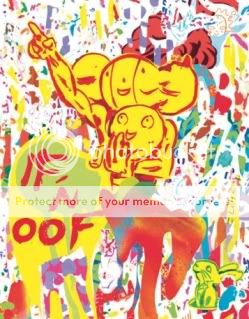 If ‘n Oof
If ‘n Oof
Brian Chippendale, writer/artist
PictureBox, October 2010
800 pages
$29.95
Buy it from PictureBox
Buy it from Amazon.com
Hey, have you played the new Brian Chippendale game yet? I’m only exaggerating slightly when I say that reading each successive Chippendale/PictureBox graphic novel is like getting a new installment in your favorite video game series, one that shakes up the gameplay but still feels like an immersion in the original spirit you loved. From Ninja‘s giant-sized hardcover presentation, bright, buoyant black and white art, and slip-sliding layout; to Maggots‘ furtive samizdat scrawled-on-a-used-book origin, dense dark panels, and hiccuppy panel flow; and now to If ‘n Oof‘s doorstop thickness, manga-digest trim size, buddy-action-comedy tone, and one-panel-per-page design, they’re all uniformly and unmistakably Chippendale in story, art, and tone, but vastly different in terms of the sensory effect reading them has. They’re experiential, is what I’m saying–as much about the act of reading as about what is read.
If ‘n Oof has been billed as the most accessible of the three, and for good reason. There’s no tricky snake-style panel layout to follow: Every page is a splash page! The consequent ability of Chippendale to pretty much know for certain how the reader’s experience will be paced–there’s only so much time it’ll take you to take in each standalone image and either look at the next one or turn the page–enables him to perfectly mimic the beats of an action comedy: an out-of-nowhere save by an offscreen ally; “I’m gettin’ too old for this shit”-style takes when something particularly outlandish presents itself; big spectacular drawn-out leaps through high-rise windows to safety. There was one (hugely important to the story!) reference to Die Hard so explicit I laughed out loud, and hard–not least because it was an enormously emotionally effective reference to boot! Working in this format provides Chippendale with mainstream visual and rhythmic touchstones previously unavailable to him, and it pays off.
Chippendale appears to sense this, and returns the format’s favor by providing his most straightforward story yet. In place of the disjointed purgatorial wanderings of Maggots and the sprawling Deadwood-style story of a criminalized community of Ninja, you’ve got a pretty easy to grok post-apocalyptic sci-fi buddy road movie, with big-eared If and his tiny, mute companion Oof marching through various dangers en route to safety. There are none of the graphically violent or sexual asides or interludes with which Chippendale peppered his earlier works, either; aside from a memorably but not particularly shockingly gross encounter with a tribe of marauding monster-men (It Came from a Mat Brinkman Comic!!!), the violence here is mostly action-blockbuster R-rated level. And even in terms of individual visuals, there are images here that use a smoother line and more traditionally detailed construction than I’ve ever seen from the author before–vast cathedrals that look like something out of Craig Thompson’s Carnet de Voyage, long hallways that evoke the robotic geometry of Yuichi Yokoyama, fields of flowers that wouldn’t look out of place as the endpapers of a Charles Burns comic. They’re impressive moments, but they’re also funny moments for how accessible they are, as if Chippendale was saying “You think I need to do this jagged-edge markmaking shit all the time? Think again, pal.”
But as breezy and adventurous and action-packed and funny and fun as it all was, I started to wonder: “Where’s the bite?” For all his emphasis on comics-as-play, for all his character designs that look like a cross between forgotten He-Man villains and those little pink M.U.S.C.L.E.S toys, for all his obvious love of genre, Chippendale’s comics have a not-so-secret scathing heart–an indictment of contemporary capitalism, the way it disregards and dehumanizes individuals with the bad fortune of getting in the way of what its robber-baron bureaucrats consider progress. Was that going on here? Turns out the answer is yes after all, thanks to the slow-burn reveal, over the course of many chapters, of a familiar-feeling, haunting science-fiction trope. I’m not going to spoil it here, but suffice it to say it calls into question the notion of whether there really ever is breezy, adventurous, action-packed, funny fun to be had. Knowing the optimism Chippendale has displayed in his real life, to say nothing of the ending of Ninja, I suspect his ultimate answer would be “yes there is”–but it ain’t gonna be easy, and that’s even true in his most user-friendly game yet.
Tags: Brian Chippendale, comics, comics reviews, Comics Time, PictureBox, reviews
